Welsh Streets, Liverpool
The Welsh Streets are a group of late 19th century Victorian terraced streets in Toxteth, Liverpool, England. The houses were designed by Richard Owens and built by Welsh workers to house migrants from Wales seeking work; the streets were named after Welsh villages and landmarks.
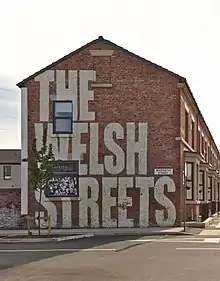 | |
 | |
| Type | Victorian Terraced Streets |
|---|---|
| Owner | Placefirst NorthWest |
| Area | Toxteth, Liverpool, England |
| Postal code | L8 |
| Coordinates | 53°23′19″N 02°57′35″W |
| Construction | |
| Completion | 1850s |
| Other | |
| Designer | Richard Owens |
| Known for | Birthplace of Ringo Starr |
| Status | Refurbished |
| Website | welshstreets |
The Beatles drummer Ringo Starr was born in Madryn Street, before moving at age 4. Although some houses were lost in World War II bombing and rebuilt, albeit in a different architectural style, many of the terraced properties in the original street configuration remain in the present day.
Following a period of decline in the late 20th century, plans were announced in the early 2000s as part of the Housing Market Renewal Initiative programme to demolish the estate and build new, but fewer, houses in their place. Despite the area being cleared of residents and houses prepared for demolition at a cost to Liverpool City Council of nearly £22 million, funding was withdrawn in 2011 following the change in government and the demolition did not take place.
Subsequent revised demolition and renewal proposals by the council and housing group Plus Dane were rejected by the government due to concerns about the negative impact they would have on the city's cultural heritage. Instead, a housing renewal company took ownership of some of the properties, initially in a pilot scheme, to extensively renovate them and make them available for rent. The first new tenants moved into Voelas Street around September 2017. Placefirst, the company renovating the properties, won an award in November 2018 for the standard of the refurbishments.
Geography

The streets include Wynnstay Street, Voelas Street, Rhiwlas Street, Powis Street, Madryn Street, Kinmel Street, Gwydir Street, Pengwern Street and Treborth Street. Other streets in the vicinity, such as Vronhill Street and Pimhill Street were built on the west side of High Park Street as shown on maps from the early 20th century,[1] although have since been lost through regeneration of newer housing.[2] The moniker Welsh Streets is given as they were constructed by Welsh builders for Welsh migrants seeking work and housing in Liverpool and named after Welsh towns, valleys and villages.[3] When constructed, the street widths were generous,[4] allowing for trees to be planted in the early 20th century which were well-spaced and did not intrude upon the housing.[5]
The streets are close to Liverpool City Centre and within 15 minutes walking distance to Liverpool Cathedral, which is clearly visible throughout the area.[6] Situated right next to the streets is Princes Park, designed and laid out by Joseph Paxton in 1840, an architect and later Member of Parliament for Coventry.[7] Median house prices in the area are below the average prices for the wider Liverpool area and nearly 90% of properties fall within Council Tax Band A, the lowest band.[8] The area falls within the Princes Park ward for local councillors.[9]
History
Early history
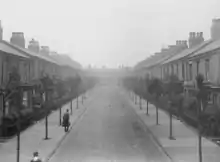
By the 1830s, Welsh migrants were well established within Welsh firms in Liverpool.[10] Maps from 1846 show that South Street, the road which runs along the end of each of the Welsh Streets, would have been a rear access lane.[11] A map from 1846-1848, prior to the housing estate construction, shows an area clear of any significant dwellings, with a tanyard located in what would become Kelvin Grove.[12]
By 1850, there were over 20,000 Welsh builders working in Liverpool who required housing. Land in Toxteth was leased for housing development,[13] with the streets designed by Richard Owens[14] and built by David Roberts, Son and Co.[10] While working on the design of Mynydd Seion chapel, Abergele in 1867, Owens came into contact with Roberts' company, who were land surveyors and subsequently became dominant in Liverpool's housebuilding industry.[15] Through his collaboration with David Roberts, Owens designed over 10,000 terraced houses in the city of Liverpool, particularly those in the surrounding Toxteth area where the Welsh Streets are located.[16] In the latter part of the 19th century, just under a third of the city's population of 450,000 were Irishmen born in Ireland, just ahead of Welsh migrant numbers, of whom there were 80,000, who had been persuaded to migrate by the promise of work.[17] Welsh migrants made significant contributions to the urban development of Victorian Liverpool.[10]
Later history
The terraced houses have outlasted many subsequent housing developments, such as towers and tenements.[18] Some properties were lost during World War II bombing[19] and were replaced during the 1950s and 1960s with housing typical of that period, but not in keeping with the original architecture.[20] The streets with post-war houses were Kelvin Grove, Wynnstay Street and Madryn Street, with the replacement houses built detached from the original houses, thus reducing the number of properties in the available space compared to the original terraced arrangement.[21] A map from the 1970s shows that partial demolition and redevelopment had already started on the opposite side of the Welsh Streets, specifically in Jolliffe Street and Foxhill Street,[21] with those streets and others to the south having been entirely redeveloped by the end of the 1980s.[2]
Around half of the houses originally constructed by Richard Owens around Liverpool had already been lost by the early 21st century, with the original clearance plans accounting for the loss of over 10% of the remaining houses.[22] In 2006, the then Leader of the Opposition David Cameron visited the streets with Michael Heseltine and said he was baffled by the proposed clearance plans.[23] The area went through a decline during the latter part of the 20th century, with half of Voelas Street being demolished[24] and properties gradually becoming derelict as residents moved out. Most of the houses were still inhabited until early 2007.[6]
Decline and Pathfinder renewal
In the early 2000s, the Housing Market Renewal Initiative programme was launched, intended to renew housing stock across the country and raise house values in perceived areas of deprivation, with the Welsh Streets area incorporated into the renewal programme. A survey in 2003 found that 72% of respondents were at least satisfied with their home and over half were at least satisfied with the quality of housing in the area, whilst only 1% believed demolition would improve the area. The renewal programme's proposals were to demolish 500 Victorian terraced houses and replace with 370 new build houses, with a smaller scale refurbishment elsewhere.[25] When the plans were submitted, over half of the properties were under social landlord control. The basis of the demolition plans was due to the location affording an attractive development site once cleared.[26]
.JPG.webp)
Council survey data published in 2005 showed the Welsh Streets were broadly popular with residents and in better than average condition, but the council nevertheless recommended demolition because of a perceived over-supply of obsolete terraced houses in Liverpool. When residents were consulted over the clearance plans in 2005, a 58% majority favoured retaining the houses over demolition.[19] In Madryn Street alone, residents voted 33-1 against plans to demolish the houses.[27] The land was offered to private developer Gleeson Group plc and social landlord Plus Dane, with proposals published for lower density houses. Some residents were happy to be offered new homes, while others were determined to stay, dividing the local community.[28] Some residents who were keen on staying expressed concern that the planned new housing would cost around double (£120,000) what they were being offered for their home (£62,000), with mortgages unlikely to be offered to older residents.[17] The Neighbourhood Renewal Assessment in 2005 stated that the environment around the Welsh Streets was bleak and that effective redevelopment following a clearance would significantly contribute towards regenerating the area.[29] Much of a property's value came from investors who acquired the properties during Liverpool's European Capital of Culture period in the hope they could profit from reselling to the local authority.[17] The majority of houses in the streets transferred ownership to the Housing Market Renewal Initiative, predominantly throughout 2005 to 2008.[30]
By 2009, over 100 residents had been rehoused together into a neighbourhood nearby which they had helped to design, whilst others had left the area altogether. Homes acquired by the council were reduced in value by 20% each year to allow transfer to the council's preferred development partner for a nominal sum, whilst still being within the legal parameters for achieving fair market value. A three-storey townhouse in Kelvin Grove, acquired for £110,000 in 2011 had been reduced in value to just £1100 by 2015.[27] Following the formation of the coalition government in 2010, schemes funded by the previous government were reviewed and ultimately funding for the pathfinder scheme was withdrawn with effect from 30 March 2011. The sudden withdrawal of funding left many schemes half-finished and some neighbourhoods only partially demolished, whilst others such as the Welsh Streets had not commenced demolition.[31]
Opinions and renewal proposals
Clearance proved contentious, with some taking the view that the houses were beyond rescue, while others believed them to be fundamentally sound. Campaigning charities led by Merseyside Civic Society and Save Britain's Heritage asserted that renovation would be preferable and cheaper.[27] Although predominantly of Victorian architecture, some of the properties had been constructed during the 1950s and 1960s as post-war replacement houses and these were described in an Affordable Housing Program assessment as having "no value in the context of the 19th century terraced houses".[32]
.JPG.webp)
In 2011, Secretary of State for Housing, Communities and Local Government Eric Pickles quashed planning permission for demolition and required an Environmental Impact Assessment. New proposals for demolition of 250 houses were endorsed by Liverpool Mayor Joe Anderson in 2012 and Housing Minister Grant Shapps, who visited the area to announce retention of 9 Madryn Street and 15 adjacent homes. Plans submitted in 2013 suggested that 150 houses could be built and 40 refurbished, including those around the house where Ringo Starr was born. The cost was estimated to be in the region of £15 million which would have seen the demolition of houses from the other surrounding Welsh Streets to be replaced with semi-detached properties. The managing director of the proposed regeneration, Claire Griffiths, suggested that 70% of residents had favoured the plans, yet housing charity Empty Homes disputed the credibility of the public opinion report, given the criteria used would have made it difficult to conclude refurbishment as a favourable option.[33] Anderson wrote to Pickles in July 2013, confirming his support on the proposed redevelopment, suggesting the decision should be a local matter and believed the scale of the proposal was "not of national importance" and with "no design or heritage issues arising".[32]
The plans ultimately fell through when in January 2015 following a public inquiry, Eric Pickles halted the demolition plans. Pickles agreed with the argument put forward by Save Britain's Heritage and the National Trust, specifically in relation to Madryn Street, in that demolition of much of the street, together with the wider Welsh Streets region would "significantly harm the ability to understand and appreciate this part of Liverpool's Beatles heritage", citing the potential impact for future tourism if the proposals had been accepted. Although the streets had not been designated as a heritage asset, Pickles disputed that the streets were of low significance[34] and believed the proposals would be significantly harmful to cultural heritage and have a detrimental impact on the character and appearance of the nearby Princes Park, directly contradicting the view of an inspector.[35]
Refurbishment
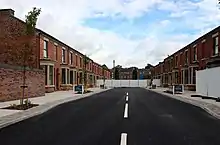
With few alternative options, refurbishment was deemed viable by the council. A partnership was agreed with Placefirst, who had experience in renewing derelict properties.[36] A pilot scheme in 2017 involved the refurbishment of houses in Voelas Street to demonstrate how the houses could be remodelled and to determine public opinion and uptake. Upon launching the scheme to prospective tenants, all properties were taken within the first weekend, with residents expected to move in around September 2017.[37] The renovations involved remodelling some floorplans and knocking through to adjacent homes to create larger houses, whilst retaining some of the original houses in order to cater for various residential requirements.[36]
Following the success of the pilot scheme, refurbishment of other Welsh Streets was approved, meaning that 300 homes would be refurbished or constructed. The council hoped that around 75% of existing housing stock could be retained, with over two thirds available to rent and around 10 percent available to purchase.[38] Long-standing vacant land on Voelas Street, Wynnstay Street and South Street became occupied by 52 new-build properties, described by the contractor as a continuation of the refurbishment of existing properties with the same landscaped communal spaces to replace the traditional yards and alleys.[39]
Aftermath
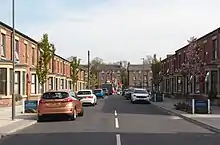
The cost to the council to instigate and process the scheme was in the region of £21.7 million, of which the majority, nearly £20.9 million was required for the purchase of properties and the associated legal fees. The cost to make the properties secure was a little over £525,000 and just over £280,000 was spent to disconnect services.[40]
In November 2018, contractor Placefirst won the Refurbishment Project of the Year Award 2018[41] and the 2018 Inside Housing Development Awards later that month, attended by more than 750 housing professionals.[42] The following year in October 2019, the project was named as the top residential scheme at the Royal Institution of Chartered Surveyors Awards Grand Final.[43] Tracey Hartley, chair of the judging panel, commented:
"The Welsh Streets is a fine example of how to breathe new life into tired, rundown terraced housing. Instead of bringing in the bulldozers, sacrificing the established street layout and embedded energy of the existing buildings, Placefirst has imaginatively refurbished the houses and surrounding areas to create desirable, modern homes in an attractive community setting."[44]
Housing and Communities Secretary Robert Jenrick MP gave a speech in October 2019, committing to the redevelopment of Victorian-era properties over demolition, specifically referring to the Welsh Streets project as being part of "a new wave of regeneration and renewal". Jenrick suggested the programme of past governments to needlessly destroy pre-1919 terraced houses was ill-fated, suggesting focus should be on sustainability and protection of communities.[45]
Notability and culture
Ringo Starr birthplace
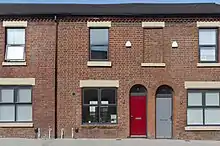
Ringo Starr, drummer for The Beatles, was born in 9 Madryn Street, where he lived until the age of 4 before moving to nearby Admiral Grove.[46] The threat to Starr's birthplace was announced in 2003, whilst a proposal was made in September 2005 to take down the house brick by brick and rebuild it as a centrepiece for the Museum of Liverpool Life, contradicting Liverpool Council's earlier claim the house had no historic value.[47] Starr said it was not worth taking the house down simply to rebuild it elsewhere, as it would not then be his birthplace. Many suggested demolition of the area surrounding Starr's home was unsatisfactory, claiming "People liked the city's character, not packaged replicas".[47]
The house forms part of Liverpool's "Magical Mystery Tour" and tourists would still visit even during the period of neglect and dereliction.[48] Among the various owners of the house were The Beatles Story, who were the registered owners in October 2010.[30]
.JPG.webp)
By 2014, the value of the derelict house had fallen to just £525, having been valued around £60,000 just the year before. At one time, the house was owned by Merseytravel with frequent tourist groups visiting the property.[49] Madryn Street remained derelict up to 2018[47] until refurbishment by Placefirst NorthWest as with the surrounding streets.[50]
Peaky Blinders TV series
One of the Welsh Streets, Powis Street, doubled as Watery Lane in 1920s Birmingham for the TV series Peaky Blinders. All house exteriors were painted black to achieve the desired look and feel of the period. Filming on the street had to cease in 2017 due to refurbishment work commencing.[51]
References
Citations
- "Side by Side map, Welsh Streets, 1890s to present day". National Library of Scotland. Retrieved 25 November 2018.
- "Old maps, Toxteth, 1970-1980s". Old Maps. Retrieved 9 February 2020.
- "Liverpool's Welsh Streets 'masterplan' approved". BBC News. 23 June 2017. Retrieved 17 February 2018.
- Fox 2015, p. 50.
- Fox 2015, p. 58.
- Fox 2015, p. 18.
- Fox 2015, p. 17.
- Chief Executive's Department 2017, p. 9.
- Chief Executive's Department 2017, p. 13.
- Carr, Dr. Gareth. "The Welsh Builder in Liverpool" (PDF). Liverpool Welsh. Retrieved 28 November 2015.
- Fox 2015, p. 64.
- "Map of Toxteth, 1846-1848". National Library of Scotland. 1848. Retrieved 9 February 2020.
- "History of Toxteth's terraced streets is the focus of new BBC documentary". Liverpool Echo. 26 May 2016. Retrieved 18 February 2018.
- "Glyndŵr University academic backs bid to save Liverpool's historic Welsh Streets". Glyndŵr University. 29 June 2015. Retrieved 28 November 2015.
- Sharples 2004, p. 144.
- Toner, Christine (23 February 2018). "The Welsh Connection: How Wales has helped shape Liverpool". YM Liverpool.
- "Farewell Liverpool's Welsh streets". Liverpool Echo. 22 September 2005. Retrieved 3 February 2019.
- Fox 2015, p. 41.
- Fox 2015, p. 59.
- "Side by Side map, Welsh Streets, 1950s to present day". National Library of Scotland. Retrieved 9 February 2020.
- "Old maps, Toxteth, 1970-1977". Old Maps. Retrieved 17 February 2020.
- Fox 2015, p. 86.
- Save Britain's Heritage. "Historic Streets face bulldozer - planning application initiated to demolish 450 houses in Liverpool". Retrieved 8 February 2020.
- "Old maps, Toxteth, 1990s". Old Maps. Retrieved 9 February 2020.
- Harrison 2016, p. 198.
- Fox 2015, p. 19.
- Fox 2015, p. 20.
- Gabriel, Clare (20 May 2005). "City's Welsh streets face threat". BBC News. Retrieved 2 February 2009.
- Thorby 2014, p. 8.
- "Vacant properties in the Liverpool area, as of 2013". Liverpool City Council. What Do They Know. 3 September 2013. Retrieved 21 April 2020.
- "Written evidence submitted by the Chairs of the Housing Market Renewal Pathfinders". Parliament.uk. March 2011. Retrieved 23 February 2020.
- "Plus Dane Planning Application report". WhatDoTheyKnow. 29 July 2013. Retrieved 8 February 2020.
- "£15m plans for Liverpool's Welsh Streets unveiled". Liverpool Echo. 21 February 2013. Retrieved 17 February 2018.
- Pitt 2015, p. 3.
- "Application by Plus Dane Group at Princes Park, the Welsh Streets, Liverpool L8" (PDF). Department for Communities and Local Government. 15 January 2015. Retrieved 17 February 2020.
- "In Liverpool, a rare housing story to celebrate". The Guardian. 27 August 2017. Retrieved 18 February 2018.
- "Placefirst completes first stage of Welsh Streets". Placefirst NorthWest. 15 August 2017. Retrieved 17 February 2018.
- "Liverpool's Welsh Streets 'masterplan' approved". Liverpool Echo. 23 June 2017. Retrieved 26 November 2018.
- "Placefirst Submit Plans for First New-Build Homes at Award Winning Welsh Streets Development". Placefirst. 17 January 2019. Retrieved 27 May 2019.
- "Freedom of Information Request - Welsh Streets Scheme costs" (PDF). What Do They Know. 13 December 2018. Retrieved 1 January 2019.
- "Projects: Building Awards 2018 Refurbishment winner - Welsh Streets". Building. 14 November 2018. Retrieved 26 November 2018.
- "Welsh Streets wins Best Build-to-Rent Development at 2018 Inside Housing Development Awards". Placefirst. 6 December 2018. Retrieved 19 April 2020.
- "Regeneration of Toxteth's Welsh Streets named top UK residential project". YM Liverpool. 5 October 2019. Retrieved 6 October 2019.
- "Transformation of Welsh Streets named UK's Best Residential Project". Placefirst. 7 October 2019. Retrieved 17 April 2020.
- "Heritage speech by the Housing Secretary". Gov.uk. 23 October 2019. Retrieved 17 April 2020.
- Taylor, Matthew (January 2, 2011). "Housing minister tries to save Ringo Starr's childhood home". The Guardian. Retrieved 26 May 2020.
- Clover, Charles (19 September 2005). "Ringo Starr's old house to be taken down and stored as 11 streets are demolished". The Telegraph. Retrieved 1 December 2018.
- "This is what it's really like on board the Magical Mystery Tour bus". Liverpool Echo. 26 December 2017. Retrieved 15 February 2020.
- "Ringo Starr's childhood home in Liverpool is now worth less than £600". Liverpool Echo. 10 October 2014. Retrieved 1 December 2018.
- "Day Trippers: Beatles fans in Liverpool – photo essay". The Guardian. 9 April 2020. Retrieved 21 April 2020.
- "Why the Peaky Blinders are being forced out of Liverpool". Liverpool Echo. 9 December 2018. Retrieved 1 December 2018.
Sources
- Chief Executive's Department (2017). Ward Profile, Princes Park (PDF). Liverpool City Council. Retrieved 18 April 2020.CS1 maint: uses authors parameter (link)
- Fox, Mike (January 2015). The Welsh Streets Public Inquiry: A report from SAVE Britain's Heritage (PDF). Retrieved 1 December 2018.CS1 maint: ref=harv (link)
- Harrison, Joanne (2016). Heritage conservation – the forgotten agenda in Victorian terraced communities in Chitty, G. ed. Heritage, Conservation and Communities: Engagement, participation and capacity building p.192-211. Taylor and Francis. ISBN 9781317122357.CS1 maint: ref=harv (link)
- Pitt, Julian (15 January 2015). Town and Country Planning Act 1990 – Section 77, Application by Plus Dane Group at Princes Park (the Welsh Streets), Liverpool, L8 (PDF). Department for Communities and Local Government. Retrieved 26 November 2018.CS1 maint: ref=harv (link)
- Sharples, Joseph (2004). Liverpool. Pevsner Architectural Guides. New Haven, US and London: Yale University Press. ISBN 978-0-300-10258-1.
- Thorby, C. (22 September 2014). Report to the Secretary of State for Communities and Local Government (PDF). The Planning Inspectorate. Retrieved 26 November 2018.CS1 maint: ref=harv (link)
Further reading
| Wikimedia Commons has media related to Welsh Streets, Liverpool. |
Application for planning permission by Plus Dane Group, 22 September 2014